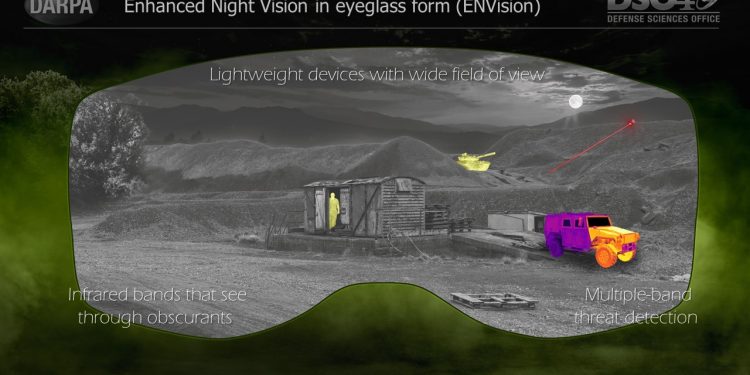| DARPA Selects Teams to Develop Lightweight, Enhanced Night Vision Goggles
美国防高级研究计划局(DARPA)选择团队开发轻型增强型夜视镜 Date:2022-01-15 Source:Technology News By:Defensetalk Viewed: |
by DefenceTalk January 13, 2022 in Technology News
由Defensetalk于2022年1月13日在《科技新闻》上发表

DARPA has selected 10 industry and university research teams for the Enhanced Night Vision in Eyeglass Form (ENVision) program.
美国国防部高级研究计划局(DARPA)已经选择了10个工业和大学研究团队,参与“眼镜式增强型夜视仪”(ENVision)计划。
Current night vision (NV) systems are bulky and heavy, resulting in a significant torque on the wearer’s neck. This torque greatly limits the wearer’s agility and often leads to chronic injury over prolonged use. Additionally, existing NV devices only provide a narrow field of view (FOV) and are limited to the near-infrared (IR) spectral bands, greatly limiting situational awareness in varied night conditions.
当前的夜视(NV)系统体积庞大且笨重,导致佩戴者的脖子产生很大的扭矩。这种扭矩极大地限制了佩戴者的敏捷性,并且经常在长时间使用后导致慢性损伤。此外,现有的NV设备仅提供窄视野(FOV),并且仅限于近红外(IR)光谱带,极大地限制了各种夜间条件下的态势感知。
ENVision seeks to leverage recent advances in planar optics and transduction materials to develop NV systems that don’t require bulky image intensifiers, provide wider FOV, offer enhanced visual access across infrared bands, and are lightweight to reduce neck strain caused by today’s technology.
“眼镜式增强型夜视仪”(ENVision)寻求利用平面光学和转换材料的最新进展来开发NV系统,这些系统不需要笨重的图像增强器,提供更宽的视野(FOV),提供跨红外波段的增强视觉访问,并且重量轻,以减少由当今技术引起的颈部疲劳。
Five teams were selected in each of two technical areas.
在两个技术领域各选择了五支队伍。
In the first technical area, performers are tasked to develop multi-band, wide FOV planar optics and planar image intensifiers to demonstrate advanced night vision systems imposing near-zero torque on the wearer. The following research teams will work to develop these capabilities:
在第一个技术领域,参与者的任务是开发多波段、宽视野(FOV)平面光学器件和平面图像增强器,以演示对佩戴者施加接近零扭矩的先进夜视系统。以下研究团队将致力于开发这些能力:
·Physical Sciences, Inc., Meta-Optic InfraRed-Enhancing (MOIRE) Eyewear
·Raytheon Technologies Research Center, Thin-film Avalanche Up-conversion and Imaging System (TAUIS)
·SRI International, Advanced Meta-optic and Planar-image-intensifier-system for Enhanced Dual-band NVG
·University of California-San Diego, novel low-noise gain processes for enhanced upconversion
·University of Washington, Scalable Hybrid-optics Integrated Night-vision Eyeglass (SHINE)
·物理科学公司(PSI),偏振光学红外增强(MOIRE)眼镜
·雷神技术研究中心,薄膜雪崩上转换和成像系统(TAUIS)
·斯坦福国际研究院,先进的偏振光学和平面图像增强器系统,用于增强双波段夜视眼镜(NVG)
·加利福尼亚大学圣地亚哥分校,用于增强上转换的新型低噪声增益处理
·华盛顿大学,可扩展混合光学集成夜视眼镜(SUNE)
In the second technical area, teams will explore new methods to amplify photonic up-conversion processes from any infrared band to visible light to enable future “intensifier-free” night vision systems. Teams selected for this technical area are:
在第二个技术领域,团队将探索新方法,将光子上转换过程从任何红外波段放大到可见光,以实现未来的“无增强器”夜视系统。入选该技术领域的团队有:
·Raytheon BBN, III-nitride flat optics device for broadband infrared to visible nonlinear conversion
·Stanford University, excitonic circuitry enables nightglow up-conversion
·University of Central Florida, coherent up-conversion by broadband extreme-confinement metamaterials
·University of Melbourne, efficient infrared-to-visible up-conversion with an upconverting nanoparticle micro laser
·University of Pennsylvania, broadband efficient up-conversion through bound states in the continuum in LiNbO3 photonic crystals
·雷神BBN技术公司,III-氮化物平面光学器件,用于宽带红外到可见光非线性转换
·斯坦福大学,激子电路可实现夜间辉光上转换
·中佛罗里达大学,宽带极端约束超材料的相干上转换
·墨尔本大学,使用上转换纳米粒子微型激光器进行有效的红外到可见光上转换
·宾夕法尼亚大学,通过LiNbO3光子晶体连续体中的束缚态进行宽带高效上转换
“The teams in the first technical area are developing technologies that could drastically reduce the bulk and volume of objective, intensifier, and eyepiece of a night vision system,” said Rohith Chandrasekar, ENVision program manager in DARPA’s Defense Sciences Office.
国防高级研究计划局国防科学办公室“眼镜式增强型夜视仪”(ENVision)项目经理罗希思·钱德拉塞卡说:“第一个技术领域的团队正在开发技术,这些技术可以大大减少夜视系统中物镜、增强器和目镜的体积和体积。”。
“Teams in the second technical area are exploring ways to directly upconvert and amplify light from the infrared to the visible using new materials and up-conversion processes. These efforts could potentially lead to all-optical night vision systems in the future without the need for image intensifiers.”
“第二个技术领域的团队正在探索使用新材料和升频转换工艺将红外光直接升频转换和放大到可见光的方法。这些努力有可能在未来发展出无需图像增强器的全光夜视系统。”
上一篇:DOD’s Autonomous Vessel Sails Through Transit Test, Participates in Exercise Dawn Blitz 下一篇:Israel buys three Dakar submarines from Germany
| Here are the bunker-buster bombs used on Iran’s Fordo nuclear facility
这是用于伊朗福尔多核设施的碉堡炸弹 |
| In inserting itself into Israel’s war against Iran, the U.S. unleashed its massive “bunker-buster” bombs on Iran’s Fordo fuel enrichment plant.... [2025-07-05] |
| Ukraine's new F-16s receive secret US electronic warfare systems to counter Russi
乌克兰新获的F-16战斗机接收了美国的秘密电子战系统,以应对俄罗斯的威胁 |
| The electronic warfare systems on these Ukrainian F-16s were not part of the U.S. inventory, presenting a significant challenge for the 68th Electronic Warfare Squadron.... [2024-08-28] |
| No U.S. Navy Aircraft Carriers Deployed In The Pacific
美国海军没有在太平洋部署航母 |
| The U.S. Navy is facing a shortfall of deployed carriers in the Pacific as the buildup in the Middle East continues. ... [2024-08-27] |
| France and Serbia Successfully Conclude Negotiations for Sale of 12 Rafale Fighte
法国和塞尔维亚成功完成12架阵风战斗机的销售谈判 |
| Dassault Aviation has successfully concluded negotiations for the sale of 12 Rafale fighter jets to Serbia, marking a significant advancement in bilateral relations between France and Serbia, as reported by LaTribune.... [2024-08-27] |
